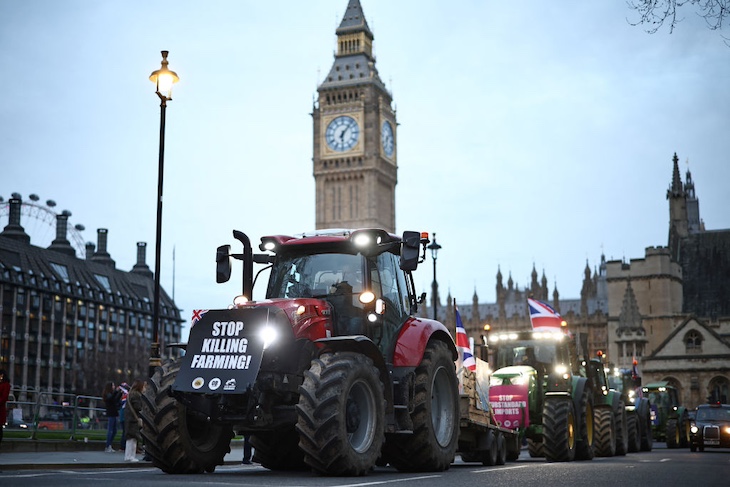There is a reason 10,000 farmers and their supporters descended on Westminster last week to protest against the government’s planned changes to inheritance tax. They know that any farm hit by the new charge will be in huge trouble. Farms are not a typical business asset – usually the value of a farming estate is far greater than any profits it generates.
This means a single inheritance tax bill could wipe out a farm’s profits for a generation. The only solution for many farmers will be to sell up or break up their farms forever.
Still, the government and its supporters say the inheritance tax change will only affect ‘very few’ farmers, around 500 a year maximum. Other groups, including the Country Land and Business Association, say 70,000 will be affected. How can these figures be so wildly different? And which is correct?
That huge difference seems to come from a combination of unreliable statistics, a complex tax system and a misuse – deliberate or otherwise – of the word ‘affected’ by the government.
The government’s figures are based on HMRC statistics which show that in 2021/22 only 462 farms claimed Agricultural Property Relief (APR) on over £1 million of assets. Now that APR has been reduced to only cover estates worth up to £1 million, they’ve assumed that only 500 or so farms will be affected by the change every year.
Quoting the annual figure minimises its full impact, of course. If 500 farms a year pay the tax, that actually means 15,000 farms are affected every generational cycle.
But while 15,000 looks like a reasonable, evidence-based assumption, for several reasons it is not.
First, it does not take into account the fact that average farm sizes have grown by a third since 2000. Mechanisation and economic pressures have meant farms need more acreage to be cost-effective. HMRC’s inheritance tax statistics mostly apply to an older generation of farmers who died before that growth. It’s likely that a higher proportion of current farmers are over the £1 million allowance.
Second, inheritance tax reliefs are more complicated than many people (perhaps even the Treasury) realise.
There are strict tax definitions for what is classed as ‘Agricultural Property’. On a modern farm, lots of assets – such as expensive machinery, horse livery businesses, or farmhouse B&B rooms – won’t qualify for APR. They might qualify for Business Relief (BPR) instead, though. Which means when farmers apply for inheritance tax relief, they will be using a mix of APR, BPR, and other reliefs.
What does this mean for famers after the Budget? Take a farm which currently claims £900,000 in agricultural relief, and £900,000 in business relief. Although the estate is worth £1.8 million, it would not be flagged by HMRC as one of the 500 farms potentially affected by the inheritance tax change. Unfortunately for this farm, the Budget has combined the APR and BPR allowance. So a farm which was facing no inheritance tax, will suddenly have to pay a hefty bill.
This could easily mean another 700 farms are affected by the changes every year. This takes us to around 36,000 farms over a generation.
That is still short of the 70,000 predicted to be affected by the Country Land and Business Association. What explains the difference? I think it is being hidden behind that little weasel word, ‘affected’.
The government (and others, including BBC Verify) have estimated how many farmers might have to pay the tax. But they have described that as the number of people affected by the tax. But the two are not the same. Many more will be affected, because of inheritance tax’s ‘seven-year rule’.
If you do it right, inheritance tax is only paid if the donor dies within seven years of passing his farm down. If you survive seven years there’s no inheritance tax at all. And you don’t appear in HMRC’s inheritance tax statistics.
But the threat of inheritance tax still hangs over that farm for seven years. With tax reliefs now restricted, a death at the wrong time could mean losing your farm, home and livelihood to a huge inheritance tax bill.
The younger generation will have to worry for seven years that everything they’re working for could be taken off them to pay a tax bill. Or buy expensive life insurance that the farm can barely afford. Or cut back on essential investment to save money. Or set up complicated and expensive tax arrangements.
All of these farming families will be seriously affected by the Budget, but they aren’t included in the government’s ‘500’ statistic because they might not have to actually pay any extra tax.
With all this in mind, let’s try and put a figure on it. As we’ve seen, the government’s ‘500 a year’ really means 15,000 a generation. The complex APR/BPR issue takes us to something like 35,000. If increased farm sizes adds 20 per cent, we’re at 42,000 paying the tax. Finally, if, say a third of farms are now either being passed on before death or taking decent tax advice, we arrive at a total number of affected farms of something like 63,000.
These are very rough estimates, but 63,000 is remarkably close to the CLBA’s estimate of 70,000 affected farms. It seems very likely that the farmers – and not the Treasury – are right about how many will be affected by this Budget.







Comments